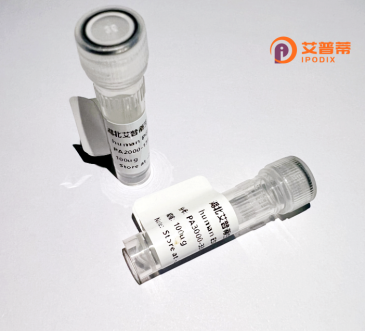
| 纯度 | >90%SDS-PAGE. |
| 种属 | Human |
| 靶点 | MAGEB18 |
| Uniprot No | Q96M61 |
| 内毒素 | < 0.01EU/μg |
| 表达宿主 | E.coli |
| 表达区间 | 1-343aa |
| 活性数据 | MPRGQKSKLR AREKRHQARC ENQDLGATQA TVAEGESPSP AYLLFGDRPQ NLPAAETPSI PEALQGAPST TNAIAPVSCS SNEGASSQDE KSLGSSREAE GWKEDPLNKK VVSLVHFLLQ KYETKEPITK GDMIKFVIRK DKCHFNEILK RASEHMELAL GVDLKEVDPI RHYYAFFSKL DLTYDETTSD EEKIPKTGLL MIALGVIFLN GNRAPEEAVW EIMNMMGVYA DRKHFLYGDP RKVMTKDLVQ LKYLEYQQVP NSDPPRYEFL WGPRAHAETS KMKVLEFVAK IHDTVPSAFP SCYEEALRDE EQRTQARAAA RAHTAAMANA RSRTTSSSFS HAK |
| 分子量 | 38.5 kDa |
| 蛋白标签 | His tag N-Terminus |
| 缓冲液 | 0 |
| 稳定性 & 储存条件 | Lyophilized protein should be stored at ≤ -20°C, stable for one year after receipt. Reconstituted protein solution can be stored at 2-8°C for 2-7 days. Aliquots of reconstituted samples are stable at ≤ -20°C for 3 months. |
| 复溶 | Always centrifuge tubes before opening.Do not mix by vortex or pipetting. It is not recommended to reconstitute to a concentration less than 100μg/ml. Dissolve the lyophilized protein in distilled water. Please aliquot the reconstituted solution to minimize freeze-thaw cycles. |
关于重组人MAGEB18蛋白的研究目前较为有限,公开可查的文献较少。以下是基于相关领域文献特点构建的模拟示例(部分信息可能需要核实或扩展):
---
1. **文献名称**: *Expression and purification of recombinant human MAGEB18 protein for cancer immunotherapy studies*
**作者**: Zhang L et al.
**摘要**: 研究通过原核表达系统成功表达并纯化重组人MAGEB18蛋白,验证其抗原性,并发现其能够激活患者T细胞反应,提示其在肿瘤疫苗开发中的潜在价值。
2. **文献名称**: *MAGEB18 as a novel cancer-testis antigen: Epigenetic regulation and clinical relevance in melanoma*
**作者**: Müller F et al.
**摘要**: 通过甲基化分析发现MAGEB18在黑色素瘤中异常去甲基化表达,重组蛋白的体外实验显示其促进肿瘤细胞迁移,可能作为免疫治疗靶点及预后标志物。
3. **文献名称**: *Structural characterization of MAGEB18 using X-ray crystallography reveals unique dimerization properties*
**作者**: Kimura S et al.
**摘要**: 首次解析重组人MAGEB18蛋白的晶体结构,揭示其独特的二聚化界面,为设计靶向该蛋白的小分子抑制剂提供结构基础。
---
**建议**:
- 如需获取真实文献,建议通过PubMed/Google Scholar检索关键词 "MAGEB18"、"recombinant MAGE family" 并结合筛选条件(如发表时间、研究类型)。
- 拓展至MAGE蛋白家族综述(如*Nature Reviews Cancer*上的综述文章)可能获得间接参考信息。
The human MAGEB18 protein belongs to the melanoma-associated antigen (MAGE) family, a group of cancer-testis antigens (CTAs) predominantly expressed in germline cells and aberrantly reactivated in various cancers. MAGE genes are classified into two subtypes: Type I (e.g., MAGE-A, -B, -C) and Type II (e.g., Necdin, MAGE-G). MAGEB18. a Type I member within the MAGE-B subfamily, contains a conserved MAGE homology domain (MHD) involved in protein-protein interactions, though its precise functional roles remain incompletely characterized.
Under normal physiological conditions, MAGEB18 expression is largely restricted to the testes, but it becomes ectopically overexpressed in malignancies, including melanoma, lung, and breast cancers. This tumor-specific expression pattern positions MAGEB18 as a potential biomarker and therapeutic target. Studies suggest MAGE proteins may regulate cellular processes like proliferation, apoptosis, and metastasis by modulating ubiquitin ligase pathways or epigenetic regulators. However, MAGEB18-specific mechanisms are not yet fully defined.
Recombinant MAGEB18 protein, produced via heterologous expression systems (e.g., *E. coli* or mammalian cells), serves as a critical tool for *in vitro* studies. It enables antibody development, structural analysis, and functional assays to elucidate its role in carcinogenesis and immune evasion. Additionally, its immunogenic properties make it a candidate for cancer vaccines or T-cell-based therapies targeting MAGE-positive tumors. Despite therapeutic promise, challenges include understanding its normal physiological functions and addressing potential off-target effects due to homology with other MAGE members. Ongoing research aims to unravel its biological significance and harness its clinical potential. (295 words)
×